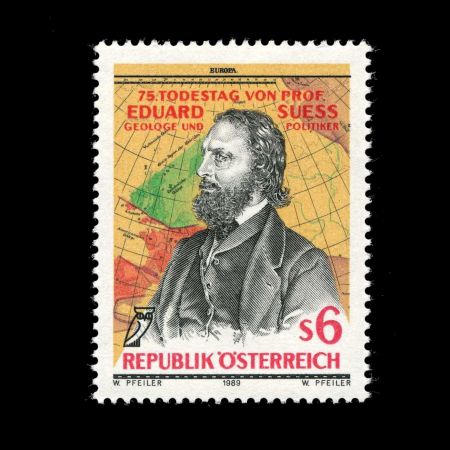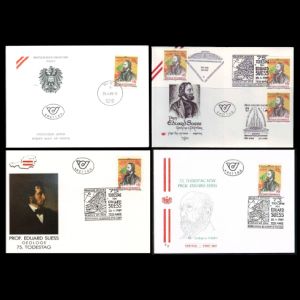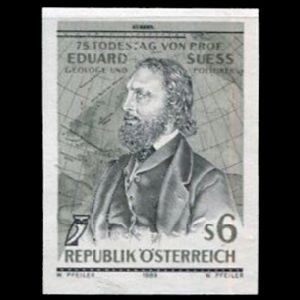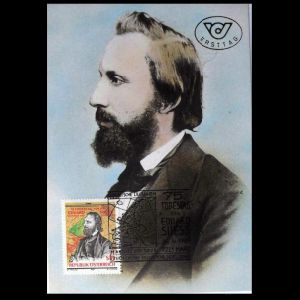Austria 1989 "75th Commemoration of the Death of Professor Eduard Suess"
| <prev | back to index | next> |
| Issue Date | 26.04.1989 |
| ID | Michel: 1951 Scott: 1454, Stanley Gibbons: 2192, Yvert & Tellier: 1781, Category: Co |
| Designer | Werner Pfeiler |
| Stamps in set | 1 |
| Value | s6 - Eduard Suess (1831-1914) Geologist and Politic |
| Emission/Type | commemorative |
| Issue place | Vienna |
| Size (width x height) | 30mm x 39mm |
| Layout | 50 stamps in sheet (10x5) |
| Products | FDC x1 |
| Paper | |
| Perforation | 14.25 x 13.5 |
| Print Technique | Lithography + photogravure, multicolor |
| Printed by | Österreichische Staatsdruckerei |
| Quantity | 2,860,000 |
| Issuing Authority | Post of Austria |

On 26th April, 1989, the Post of Austria, issued the stamp "75th Commemoration of the Death of Professor Eduard Suess".
The geologist and politician Eduard Suess was born in London on August 20, 1831. He was full professor of geology at the University of Vienna and at the same time a full member of the Vienna Academy of Sciences. His first book "Der Boden der Stadt Wien" ("The Soil of Vienna"), which dealt with the correlation of geologic conditions and water supply, marked the beginning of his increasing scientific recognition from that time forward.
He gradually developed views on the connection between Africa and Europe; eventually he came to the conclusion that the Alps to the north were once at the bottom of an ocean, of which the Mediterranean was a remnant.
While not quite correct (mostly because plate tectonics had not yet been discovered - he used the earlier geosyncline theory), this is close enough to the truth that he is credited with postulating the earlier existence of the Tethys Ocean, which he named in 1893.
Suess postulated that as sediments filled the ocean basins the sea levels gradually rose, and periodically there were events of rapid ocean bottom subsidence that increased the ocean's capacity and caused the regressions. This became known as the theory of eustasy (eustacy).
His other major theory involved glossopteris fern fossils occurring in South America, Africa, and India (as well as Antarctica, though Suess did not know this). His explanation was that the three lands were once connected in a supercontinent, which he named Gondwanaland. Suess proposed that land bridges would rise out of the oceans to connect land masses together - allowing animals to walk across the bridges to spread to other continents (of course this was influenced by the early suggestions of the Bering Sea Land Bridge between Eurasia and North America where sea level change related to the Pleistocene glaciations allowed bridges to develop). Unfortunately, his model was developed before scientists had examined the rock beneath the oceans (dense basalt) or had developed models of continental drift. He also had no mechanism to explain how the bridges popped up and later dropped down. Still, it is so similar to what is currently believed that his naming has stuck.
It is less known, Eduard Suess discovered some dinosaur bones and some dinosaur species named after him.
In 1859, a young professor Eduard Suess (appointed professor of paleontology at the University of Vienna in 1856) and his student Ferdinand Stoliczka, who became a prominent geologist and paleontologist later on, came to explore the "Gute Hoffnung" mine at Muthmannsdorf in Austria.
Ferdinand Stolicka (1838-1874), shown on a stamp of Czech Repiblic in 2008.

|
|
Reconstruction of Struthiosaurus austriacus
in the middle of a late Cretaceous forest in what today is Lower Austria, South of Vienna,
by Fabrizio De Rossi. Image and description credit: Deviant Art. |
The Grünbach Formation is an Austrian geological formation that dates to the lower Campanian age of the Late Cretaceous. It forms part of the Gosau Group, and represents a marine regression event, representing a coastal/brackish environment, being underlain by the marine carbonate Maiersdorf Formation and overlain by the deep marine siliciclastic Piesting Formation.
Suess and Stoliczka subsequently uncovered numerous bones of several species, such as Megalosaurus, a turtles, crocodiles, dinosaurs and a pterosaur.All these fossils were stored in the museum of the University of Vienna but received little attention until 1870, when Austrian paleontologist Emanuel Bunzel came to study them.
Bunzel published result of his study in the following year in monograph "Die Reptilfauna der Gosauformation in der Neuen Welt bei Wiener Neustadt". The English translation of the title is "The reptile fauna of the Gosau Formation in the New World near Wiener Neustadt".
One of the prehistoric animals described by Bunzel is a new genus and species of dinosaur Struthiosaurus austriacus.
Struthiosaurus is one of the smallest known and most basal genera of nodosaurid dinosaurs, with estimated length of 2.2 meters only. The dinosaur lived in the Late Cretaceous period (Santonian-Maastrichtian) on the territory of Austria, Romania, France and Hungary.
Some other dinosaur bones were assigned by Bunzel to a new species Iguanodon suessii (named after Eduard Suess). Later on, Iguanodon suessii was reassigned to a new genus Mochlodon and the species renamed to Mochlodon suessii.Mochlodon is a genus of iguanodontian ornithopod dinosaurs (Rhabdodontidae) who lived during the Late Cretaceous (85-80 million years ago) on the territory of Austria and Hungary.
In the summary of his monograph (page 17) Bunzel wrote: "Of the great interest is therefore not only the occurrence of such diverse forms in a single locality, but also the fact that these dinosaur remains are the first to be found in the Austrian empire and even in all of Europe in such Late Cretaceous strata."Products
| FDC (personalized) | Black print [1] | Maxi Card (personalized) |
 |
 |
 |
Notes:
[1] The Black Print is an ungummed, imperforate proof printed in black from the original printing plates. Black prints are distributed by the Austrian Post, but are not valid postage.
References
- Eduard Suess: Wikipedia
- Struthiosaurus: Wikipedia; "Die Reptilfauna der Gosauformation in der Neuen Welt bei Wiener Neustadt", Emanuel Bunzel, Wien, 1871 (in German); website of Winzendorf Muthmannsdorf community (in German);
- Mochlodon: Wikipedia
- Grünbach Formation: Wikipedia;
Acknowledgements:
Many thanks to Dr. Peter Voice from Department of Geological and Environmental Sciences, Western Michigan University, for his help to find an information for this article, the draft page review and especially for the text about opalisation process written by him.
| <prev | back to index | next> |